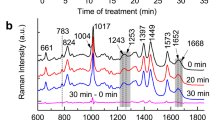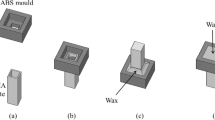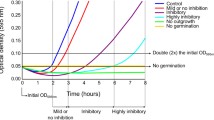Abstract
Germination of Bacillus anthracis spores is necessary for the transcription of plasmidic genes essential to the infection. Assessing germination potential is crucial to predict the risk associated with pathogenic Bacillus exposure. The aim of this study was to set up a viability assay based on membrane potential in order to predict the earliest germination event of spores. B. cereus and two strains of B. subtilis were used. The spores were isolated with a sodium bromide gradient. Approximately 107 spores were incubated at 37°C in tryptic soy broth (TSB). Aliquots were harvested at predetermined times and stained with 3,3′-dihexyloxacarbocyanine iodide [DiOC6(3)] or with bis-(1,3-dibutylbarbituric acid) trimethine oxonol [DiBAC4(3)]. Fluorescence characteristics were obtained using flow cytometry. The earliest detectable activation of membrane potential occurred after 15 min of incubation in TSB using DiOC6(3). Using DiBAC4(3), the earliest detectable signal was after 4 h of incubation. Control experiments using carbonyl cyanide m-chlorophenylhydrazone (CCCP)-treated spores did not show any change in the fluorescence intensity over time. Since no membrane potential and no germination were detected in CCCP-treated spores, the activation of membrane potential seems to be associated with germination. DiOC6(3) can be used as an early membrane potential indicator for spores. DiBAC4(3), by contrast, is not a early membrane potential marker.



Similar content being viewed by others
References
Barer MR, Harwood CR (1999) Bacterial viability and culturability. Adv Microb Physiol 41:93–137
Bhupathiraju VK, Hernandez M, Landfear D, Alvarez-Cohen L (1999) Application of a tetrazolium dye as an indicator of viability in anaerobic bacteria. J Microbiol Methods 37:231–243
Cabrini G, Verkman AS (1986) Potential-sensitive response mechanism of diS-C3-(5) in biological membranes. J Membr Biol 92:171–182
Charon NW, Greenberg EP, Koopman MB, Limberger RJ (1992) Spirochete chemotaxis, motility, and the structure of the spirochetal periplasmic flagella. Res Microbiol 143:597–603
Chitara LG, Breewer P, Van Den Bulk RW, Abee T (2000) Rapid fluorescence assessment of intracellular pH as a viability indicator of Clavibacter michiganensis subsp. michiganensis. J Appl Microbiol 88:809–816
Comas-Riu J, Vives-Rego J (2002) Cytometric monitoring of growth, sporogenesis and spore cell sorting in Paenibacillus polymyxa (formerly Bacillus polymyxa). J Appl Microbiol 92:475–481
Deere D, Porter J, Edwards C, Pickup R (1995) Evaluation of the suitability of bis-(1,3-disbutylbarbituricacid) trimethine oxonol, (diBA-C4(3)−), for the flow cytometry assessment of bacterial viability. FEMS Microbiol Lett 130:165–170
Dimroth P (2000) Operation of the F0 motor of the ATP synthase. Biochim Biophys Acta 1458:374–386
Edwards C (2000) Problems posed by natural environments for monitoring microorganisms. Mol Biotechnol 15:211–223
Helgason E, Okstad OA, Caugant DA, Johansen HA, Fouet A, Mock M, Hegna I, Kolsto AB (2000) Bacillus anthracis, Bacillus cereus, and Bacillus thuringiensis—one species on the basis of genetic evidence. Appl Environ Microbiol 66:2627–2630
Jepras RI, Paul FE, Pearson SC, Wilkinson MJ (1997) Rapid assessment of antibiotic effects on Escherichia coli by bis-(1,3-dibutylbarbituric acid) trimethine oxonol and flow cytometry. Antimicrob Agents Chemother 41:2001–2005
Kaprelyants AS, Kell DB (1992) Rapid assessment of bacterial viability and vitality by rhodamine 123 and flow cytometry. J Appl Bacteriol 72:410–422
Keer JT, Birch L (2003) Molecular methods for the assessment of bacterial viability. J Microbiol Methods 53:175–183
Keynan A (1978) Spore structure and its relations to resistance, dormancy and germination. In: Chambliss G, Vary JC (eds) Spores VII. American Society for Microbiology, Washington, pp 43–53
Laflamme C, Lavigne S, Ho J, Duchaine C (2004) Assessment of bacterial endospore viability with fluorescent dyes. J Appl Microbiol 96:684–692
Manson DJ, Allman R, Lloyd D (1993) Uses of membrane potential sensitive dyes with bacteria. In: Lloyd D (ed) Flow cytometry in microbiology. Springer, Berlin Heidelberg New York, pp 67–81
Manson DJ, Allman R, Stark JM, Lloyd D (1994) Rapid estimation of bacterial antibiotic susceptibility with flow cytometry. J Microsc 176:8–16
Manson DJ, Lopez-Amoros R, Allman R, Stark JM, Lloyd D (1995) The ability of membrane potential dyes and calcofluor white to distinguish between viable and non-viable bacteria. J Appl Bacteriol 78:309–315
Moir A, Corfe BM, Behravan J (2002) Spore germination. Cell Mol Life Sci 59:403–409
Nebe-von-Caron G, Stephens PJ, Hewitt CJ, Powell JR, Badley RL (2000) Analysis of bacterial function by multi-colour fluorescence flow cytometry and single cell sorting. J Microbiol Methods 42:97–114
Nicholson WL, Law JF (1999) Method for purification of bacterial endospores from soils : UV resistance of natural Sonoran desert soil populations of Bacillus sp. with reference to B subtilis strain 168. J Microbiol Methods 35:13–21
Novo D, Perlmutter NG, Hunt RH, Shapiro HM (1999) Accurate flow cytometric membrane potential measurement in bacteria using diethyloxacarbocyanine and a radiometric technique. Cytometry 35:55–63
Rodriguez GG, Phipps D, Ishiguro K, Ridgway HF (1992) Use of a fluorescent redox probe for direct visualisation of actively respiring bacteria. Appl Environ Microbiol 58:1801–1808
Rottenberg H, Wu S (1998) Quantitative assay by flow cytometry of the mitochondrial membrane potential in intact cells. Biochem Biophys Acta 1404:393–404
Russell JB (1990) Low-affinity, high-capacity system of glucose transport in the ruminal bacterium Streptococcus bovis: evidence for a mechanism of facilitated diffusion. Appl Environ Microbiol 56:3304–3307
Sano K, Otani M, Vehara R, Kimura M, Umezawa C (1988) Primary role of NADH formed by glucose dehydrogenase in ATP provision at the early stage of spore germination in Bacillus megaterium QM B1551. Microbiol Immunol 32:877–885
Schaik W van, Tempelaars MH, Wouters JA, de Vos WM, Abee T (2004) The alternative sigma factor sigmaB of Bacillus cereus: response to stress and role in heat adaptation. J Bacteriol 186:316–325
Scott DR, Marcus EA, Weeks DL, Adrian L, Melchers K, Sachs G (2000) Expression of the Helicobacter pylori ureI gene is required for acidic pH activation of cytoplasmic urease. Infect Immun 68:470–477
Setlow P (2003) Spore germination. Curr Opin Microbiol 6:1–7
Shapiro HM (1995) Practical flow cytometry, 3rd edn. Wiley, New York, pp 418–425
Shapiro HM, Natale PJ, Kamentsky L (1979) Estimation of membrane potential of individual lymphocytes by flow cytometry. Proc Natl Acad Sci USA 76:5728–5730
Suller MTE, Lloyd D (1999) Fluorescence monitoring of antibiotic-induced bacterial damage using flow cytometry. Cytometry 35:235–241
Venkatasubramanian P, Johnstone K (1989) Biochemical analysis of the Bacillus subtilis 1604 spore germination response. J Gen Microbiol 135:2723–2733
Weiner MA, Read TD, Hanna PC (2003) Identification and characterization of the gerH operon of Bacillus anthracis endospores: a differential role for purine nucleosides in germination. J Bacteriol 185:1462–1464
Acknowledgments
The studies were undertaken under DND contract W7702-00R802/001/DEM. Dr. J. Ho was the scientific authority acting for DND. Initial ideas for these studies originated from previous work performed at DRDC. Caroline Duchaine is an IRSC/IRSST scholar.
Author information
Authors and Affiliations
Corresponding author
Rights and permissions
About this article
Cite this article
Laflamme, C., Ho, J., Veillette, M. et al. Flow cytometry analysis of germinating Bacillus spores, using membrane potential dye. Arch Microbiol 183, 107–112 (2005). https://doi.org/10.1007/s00203-004-0750-9
Received:
Revised:
Accepted:
Published:
Issue Date:
DOI: https://doi.org/10.1007/s00203-004-0750-9




